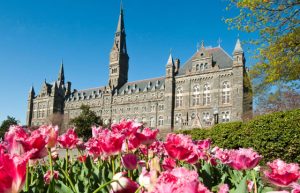It didn’t look like they were reimagining campus.
Nothing would have seemed remarkable to those who walked by the 15 people perched on plastic folding chairs in Red Square on Oct. 12, straining to hear over the roar of airplanes.
In fact, nothing seemed remarkable about the event when it was advertised; Georgetown, famous for its town halls in appearance only, was at it again. But as leaders from student environmental groups filtered in, the mood shifted. Maybe it was the fall air. Maybe it was the chance to speak and be listened to. At that moment, a sustainable future for Georgetown seemed within reach.
Or, as Noelle Gignoux (SFS ’22) said, “Access into decision-making places is something [students] have been lacking often, but I think that it is coming.”
The sustainability movement at Georgetown has been student-led and met with much resistance. Student advocates critique the lack of institutional support and transparency, while taking it upon themselves to sort through compost or explain how to recycle. Clubs designed to support university initiatives ideated, wrote, and proposed those initiatives. But at the same time, university sustainability programs ran more effectively than many knew, poorly publicized by Georgetown but worth attention. There was, to put it simply, a disconnect between ongoing university efforts and the vision students had for what campus could be.
That meeting in Red Square was the first attempt to cross that divide. Two university employees most relevant to Georgetown’s environment efforts, Vice President of Sustainability Meghan Chapple and Director of the Georgetown Environmental Initiative (GEI) Pete Marra, sat down with leaders from Georgetown Renewable Energy and Environment Network (GREEN), VegOut, GEI, and other clubs to plan what the next five years of Georgetown sustainability could look like. To a close observer, it was something akin to hope.
“This is a reinvisioning time for Georgetown on sustainability,” Chapple said. She added in an email statement, “I intend to work with the Georgetown community to unleash a culture that promotes a regenerative relationship with the planet.”
The reshaping of sustainability at Georgetown kicked off just a month and a half ago with Chapple’s hiring. For almost a decade, sustainability efforts flowed through the Office of Sustainability (OOS), until last year the office found itself with no full-time staff. A handful of student interns, key to the OOS’s function, were left in limbo, and student activists were unsure where to turn.
Then, the university announced it was hiring a vice president of sustainability.
In name, this was a leap forward in Georgetown’s commitment to sustainability, allowing Chapple to exercise oversight over all areas of campus instead of being siloed in the Department of Planning and Facilities Management like OOS had been.
“We were definitely excited about her because she was really open to student involvement, she really wanted student interns, she believed in that strongly,” Victoria Boatwright (COL ’22), former president of GREEN, said. Gignoux expressed similar optimism. “I think she does genuinely care about this as well; she’s not just here for a job.”
According to Anu Lamsal (SFS ’23), the current president of GREEN, Chapple’s track record speaks for itself. During her time at George Washington, Chapple outlined the university’s sustainability plan, which Lamsal admired. “She seems to be a lot more enthusiastic about bringing actual change to [Georgetown’s] sustainability plans, like she is pushing her own administration,” she said.
In practice, Boatwright was less optimistic about the process. Though the previous director of OOS left in January, no staff positions in the office have been filled, and Chapple has only been on the job for a month and a half.
Marra, who has been at GEI for two years, insisted that “the intent was never to shut down the office—it was to ramp it up,” a concept that students say should have been communicated earlier when OOS communications went dark during the pandemic. “To me [it] really just seemed like kicking the ball along and stalling because there are a lot of things the OOS could do,” Boatwright added.
Chapple said at the town hall that the office had been left empty so the new vice president would have free reign to reimagine sustainability initiatives with a fresh team. Once OOS finishes its move from the New South basement to a townhouse, she promised there would be staff, though no one has been hired yet. She also indicated openness to restarting OOS’s internship program, and wants to incorporate intersectionality into sustainability.
For some students, it became hard not to see this whole process as representative of how sustainability work tends to progress on campus. While the university is taking action to drastically increase sustainability efforts on campus, students feel left out of the decision-making process, saying the administration communicated too little, too late. Or, as Boatwright said:
“I am looking forward to where Georgetown is going but I am frustrated with the amount of time it has taken.”
***
You don’t have to look hard to see potentials for and failures of sustainability on campus. The decrepit solar panels atop the ICC, half-heartedly used recycling bins in Leo’s, and sometimes-renewably-powered GUTS buses all point to a campus that is trying to lessen its environmental impact. But the reality, as is so rarely true, things are actually better than they appear.
Georgetown is a leader in renewable energy: at least half the university’s electricity is currently sourced from solar and renewables, according to Chapple, which she claims is not true for most of Georgetown’s peer institutions (and most don’t have an equivalent position to hers, either).
This data, however, is not on the OOS website. To the Voice’s knowledge, it has never even been publicly announced. Boatwright argues there is a trend of Georgetown only publicizing goals after they are achieved, which limits the ability of students to actually hold the university accountable for progress.
The great irony of the university’s lack of transparency is that Georgetown is making huge strides with renewables every day. After a proposed solar panel installation in La Plata, Maryland, was widely maligned for both its location on native Piscataway land and the loss of fields of trees to create green energy, Georgetown shifted its focus to investing in existing sources of renewables.
Last October, the university committed to purchasing two-thirds of its electricity from solar farms in Maryland and New Jersey. The 15-year agreement will see Georgetown annually buying 100,000 megawatt-hours of electricity from the PJM grid, run by a regional transmission organization. Even before this agreement was fully in place, Georgetown led U.S. universities in percent of energy consumption coming from renewables.
Boatwright suspects that this move, combined with the university’s new partnership with Georgetown Energy Partners, could set the university on the path to 100 percent renewable energy. The energy partners are set to release a proposal this fall, according to Chapple, to make the university more energy-efficient.
The goal of the partnership is threefold: fully renewable energy by 2035, a 35 percent reduction in energy consumption, and carbon neutrality by 2030. As energy consumption goes down, the university is hopeful they will only need the electricity already purchased from the PJM grid.
Georgetown has not formally announced this goal to the student body, however, which makes Boatwright wonder if the university really thinks it’s feasible.
Lamsal took a dismal view: “This is a very unrealistic goal, and we have told them that, but they think somehow it’s obtainable,” she said.
While most energy consumption information is technically available online, the endowment is another story. In February of 2020, Georgetown agreed to GU Fossil Free’s (GUFF) demand that it divest its $1.9 billion endowment from all fossil fuels after six years of student advocacy. The announcement came mid-way through voting on a student referendum about whether the university should divest and has been followed with few updates.
Georgetown has long kept its investments private, and the policy has drawn repeated student criticisms about a lack of transparency, especially after previously undisclosed investments in fossil fuels came to light.
“Georgetown will divest from public securities of fossil fuel companies by 2025 and divest from existing private investments in those companies by 2030. Divestments are being made in a thoughtful manner consistent with the University’s fiduciary duty to manage the endowment prudently,” a university spokesperson wrote in an email to the Voice. “Fiduciary oversight for the endowment is vested in a subcommittee of the Board of Directors, specifically the Subcommittee on Investments of the Committee on Finance and Administration.”
Boatwright and other GUFF members are continuing to ask for accountability on divestment, even if it is just the percentage of the endowment that is fully divested. “If you deny the ways that we have asked for [accountability], then you need to present a way,” she said.
The question of accountability was laced throughout the town hall. Students pointed out that the general population lacks knowledge on some of the most basic sustainability issues, such as if the university even recycles (a long-repeated myth that members of GREEN continually try to disprove), and how far along the divestment is. Even engaged students struggle to get answers from the university about their carbon footprint, investments, and energy consumption.
Though OOS used to post sustainability reports on its website, none are available for the last ten years. “I just don’t know what is going on with those reports in terms of circulation and distribution,” GUSA Vice Speaker Rowlie Flores (COL ’22) said, adding that GUSA has been requesting the reports for years.
This information is crucial because historically, the onus has been on students to jumpstart sustainability initiatives. Even when the university began to listen, like with divestment, it often took years of campaigning to make a change.
“We have worked very closely with administration in the past, and it hasn’t always been fruitful,” Lamsal said. “Our role really is to act as a checking mechanism for administration.”
With the past year’s administrative changes, some GREEN members are hoping that job gets easier. Already, transparency from the administration has increased, according to Gignoux, who was encouraged by the return of monthly town halls with added administrative presence.
Chapple also seemed receptive to suggestions made at the town hall to begin a monthly newsletter with sustainability updates. “My hope is we can be really transparent about how our goals are and really transparent about how close we are to those goals or not,” she said.
Lamsal has no illusions that this will lead to perfect information sharing. “I’m still kind of skeptical simply because she is part of the administration and Georgetown really likes to sort of pull the rug out from under students.”
But any measurable increase in transparency and action from the university could shift how sustainability work is done on campus. With clubs spending so much time lobbying the university, they’ve had less available time to educate students. While GREEN has some educational programming, making that their key focus would be a sea change. It would also be a potential answer to the frustrated question Chapple asked at the town hall: “How do we get the rest of the student body on board with this?”
In the past, GREEN has advocated for sustainability education to be a key part of any new student’s orientation to Georgetown, pushing to include discussions of how to recycle and compost on campus in NSO and even creating a What’s a Hoya course in 2019, which 400 students completed—all initiatives Chapple indicated she would follow up on.
“We are so much more well-positioned to educate the student body sometimes because they are our peers, and we are learning right alongside them,” Gignoux pointed out.
The majority of that education is around waste. As a campus, Georgetown generates a considerable amount of plastic waste, which students don’t always know how to dispose of, especially with plastic-only options at Leos. During the trial period of a pilot compost program run through GREEN and OOS in 2019, students often put trash in the compost bins, according to Flores. Since that program ended, members of GREEN have been “guerilla composting” in buckets and walking or driving it to a drop-off point in Dupont Circle. According to Chapple, a reiteration of the program is set to begin in downstairs Leo’s sometime in the next few weeks, and the university is in the process of hiring a zero waste manager, though they have claimed this for the past four years.
It’s not just waste reduction that students are working on; GREEN runs a community garden aided by Aramark workers and has proposed their very own sustainability plan. Flores, meanwhile, is hoping to ensure the GUTS buses move to fully electric and the campus scooter program gets off the ground to reduce students’ carbon emissions when it comes to transportation. And new projects floated at the town hall—launching an urban farm, a solo cup reuse program, front lawn renovation—could broaden the definition of sustainability even further.
Chapple was unabashedly optimistic about where Georgetown could go. “I don’t think there are constraints,” she said. “I think there’s really an opportunity to think differently and approach things differently.”
This answer clearly surprised the students who heard it. For those who have been involved in sustainability work on campus over the last five years, sometimes it seems like constraints have characterized their time on campus: not enough staff, not enough money, not enough information, no one who will listen. These limiting factors have not disappeared; but the answer to the fundamental question, the question of can we, at this university, do our part to help our planet, is looking more and more like a yes.
This article has been updated to include a university comment.




